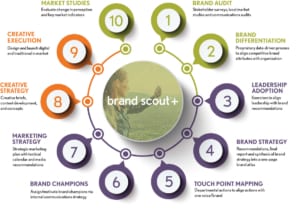
Uniquely designed for healthcare marketers by healthcare marketers, brand scout+ is your source for essential information to guide your brand strategy. (Click to learn more.)
As healthcare leaders and marketers, we all know the importance of a healthy brand – and a healthy brand, like a healthy body, requires maintenance and dedication over time. What you convey about your brand – and what you hope others will embrace about your brand – must always align with the brand experience you actually deliver. To continuously build volume, preference and market share, sometimes you need to give your brand a thorough, objective evaluation.
When that time comes, you have two options: you can find a partner who specializes in healthcare branding, or manage and complete the work internally. There is no one-size-fits-all answer – it depends on an array of factors including your in-house capabilities and capacity. Make an informed decision about whether to DIY or outsource using the following checklist and questions to govern the brand assessment and strategy process:
1. Brand Audit: Measure current perception of your brand and your competition
Use surveys, in-depth interviews and local market studies to systematically assess your healthcare brand from these varying perspectives:
- Your customers/patients
- Your community stakeholders
- Your healthcare leaders (executive team and board of directors)
- Your employees (physicians, nurses, etc.)
Next, audit your communications. Ask yourself how authentically your healthcare organization appears in:
- Advertising campaigns
- Promotional materials and sales collateral
- Web content and social media
- Proposals and estimates
- Customer communications
- Internal communications
Then go one step further by assessing your competitions’ communications, which will provide insight to guide your decisions in step two.
2. Brand Differentiation: Create a sustainable value proposition
Based on current perceptions revealed in the brand audit, identify three key attributes that describe how you differ from your healthcare competitors. Ask yourself:
- Do you have a proven process to accurately identify what makes you stand out from the competition?
- Can you objectively determine if the differentiators you identify are realistic and authentically different from the competition?
- Can you readily determine actions your organization currently does that align with the brand differentiators you’ve identified?
- Are you diving deep enough to uncover new opportunities for differentiation based on current gaps among consumer brands in your local marketplace?
3. Brand Strategy: Develop a one-page synthesis of your brand position
This internal use document should clearly and succinctly convey the following:
As you create your brand strategy document, ask yourself if it meets these important objectives:
- Can the brand strategy be deployed as the filter for future business decisions?
- Will your executive team use the brand filter when making key organizational/business decisions (e.g. capital purchases, new business development)?
- How can your board of directors use the brand filter?
- Is the document designed for organization-wide understanding and use? No jargon, no rambling – just the brand strategy in simplified terms to engage everyone.
4. Leadership Adoption: Roll out a process for ensuring what you actually do aligns with your brand differentiators
This is a critical step where your leaders outwardly refresh how they live the brand, and where they inspire others to follow suit:
- Give your executive team key talking points and a 30-second elevator speech that stays on point with the brand strategy from start to finish.
- Seize all opportunities to integrate that message into weekly employee communication.
- Embed the differentiators in materials your executive team routinely uses.
- Include your board of directors in this same process.
5. Touch Point Mapping: Devise a plan to ensure your employees live the brand
Create a matrix of current and planned behaviors for each department. Internal brand adoption takes time – and adequate guidance is essential. As you build the matrix, ask yourself:
- How can you guide each department to live the brand throughout relevant daily activities? What your employees DO every single day, and what they say in every single customer conversation, needs to align with your brand promise and differentiators.
- Are there significant changes that need to be made to ensure alignment?
- Do you have a measurement system and/or incentives in place to ensure departments keep their commitments to living the brand?
- Do you have visual aids throughout your departments as reminders of the brand promise?
6. Brand Champions: Identify brand-passionate employees to gain organization-wide support
Brand building extends far beyond your marketing department. Designate a group of employees to serve as brand champions who inspire others to live the brand. Ask yourself:
- How do you want to appoint the brand champions – ask for volunteers or delegate?
- Which employees are your best exemplars of the new brand?
- How can you represent all departments?
- How will the brand champions work together, and who will facilitate their work?
- How will you empower the brand champions to take action and sustain their influence?
- Should you set up a private Facebook group to facilitate virtual engagement with your brand champions?
- What kick-off activities/events can you implement for the brand champions?
7. Internal Communication Strategy: Make a plan for internal roll-out
Establish a strategic and tactical plan for unveiling your new brand to key stakeholders, leadership and employees, and continuously reinforcing the brand across your healthcare organization. Questions to ask:
- Does your plan include a top-down communication component?
- How long will it take to gain internal adoption before you can take the new brand to market?
- What tools can you develop to support the brand, and how can you integrate the new brand into existing employee materials?
- Can you return to your communication audit to adapt internal versus external communication aids with ease?
- How will you engage your brand champions in the internal communication strategy?
- How frequently will executive leaders communicate about brand progress, and what mode of communication will they use?
8. Marketing Strategy: Develop strategies and tactics for external communication
When you are ready to launch the new brand externally, create a one- to three-year strategy and tactical calendar. Once you have collected data-driven insights for market share, market forces and growth potential for the organization and each of its key products or service lines:
- Stratify your key brand messages by audience.
- Align your in-market tactics and media plan with your external communication strategies.
- Integrate across all communication channels.
- Ensure consistency throughout, from external to internal brand elements.
- Remember to use the brand strategy as a filter for your tactical decisions.
9. Creative Strategy and Execution: Bring your new brand to life with integrated creative materials
Create new content, complete with new design elements and visuals that align with the core purpose of your healthcare brand.
- Translate the new brand in ways that communicate effectively with various demographic groups.
- Give your color palette, fonts and images a brand boost.
- Consider a common element or thread necessary to connect your old brand to your new one, ensuring your consumers understand your brand evolution.
10. Market Studies: Continuously measure your efforts and document competitive gains
To maintain a healthy brand, you must monitor:
- Internal brand adoption
- Improvements in external awareness and perception of your brand
- Progress achieved in improving your brand’s competitive positioning
Brand building is a complex, interconnected process that requires authentic insight, objective decision-making and careful, sometimes even calculated effort. Whether embarking on a self-assessment or soliciting professional healthcare branding expertise, it is well worth the extra effort – bringing your brand back to life in the hearts and minds of your customers always is.
The process outlined above is recommended when revitalizing your brand image. For a 10-step process to redefining and communicating your brand identity, see Creating Healthier Brands: What is the Difference Between Brand Identity and Brand Image?
 For healthcare companies seeking professional branding expertise, we encourage you to learn more about brand scout+, an innovative product that delivers healthier brands.
For healthcare companies seeking professional branding expertise, we encourage you to learn more about brand scout+, an innovative product that delivers healthier brands.

 Having overseen a busy call center in a large academic medical center for many years, I know those over-the-phone touch points are among the biggest moments of opportunity to build lifetime customers. In fact, a call between a patient or consumer and a member of your staff is more than a touch point. It’s a brand moment, and it is often the customer’s first experience with your brand. Its potential to build relationships—or impair them, depending on how things are handled—should not be underestimated.
Having overseen a busy call center in a large academic medical center for many years, I know those over-the-phone touch points are among the biggest moments of opportunity to build lifetime customers. In fact, a call between a patient or consumer and a member of your staff is more than a touch point. It’s a brand moment, and it is often the customer’s first experience with your brand. Its potential to build relationships—or impair them, depending on how things are handled—should not be underestimated. Julie Amor, President and Chief Strategy Officer for Dobies Healthcare, has 30 years of experience elevating healthcare brands. Share your thoughts with her by tweeting @DobiesGroup, connecting with us on LinkedIn, or by commenting on our Facebook page.
Julie Amor, President and Chief Strategy Officer for Dobies Healthcare, has 30 years of experience elevating healthcare brands. Share your thoughts with her by tweeting @DobiesGroup, connecting with us on LinkedIn, or by commenting on our Facebook page.
 If you have recently launched a new brand at your healthcare organization, you are well aware that your brand is not a logo – your brand is an intangible asset that resides in people’s hearts and minds. It is defined by expectations developed over time though communication and, more importantly, through actions.
If you have recently launched a new brand at your healthcare organization, you are well aware that your brand is not a logo – your brand is an intangible asset that resides in people’s hearts and minds. It is defined by expectations developed over time though communication and, more importantly, through actions.
 As healthcare industry leaders look to increase efficiency, grow market share, improve outcomes, and meet consumer expectations for
As healthcare industry leaders look to increase efficiency, grow market share, improve outcomes, and meet consumer expectations for  Like any competitive environment, hospital markets include two key types of players:
Like any competitive environment, hospital markets include two key types of players: When we present a strategic marketing plan to a hospital, for example, we start with a simple statement that has enormous value. It sets the tone for the entire data-driven document:
When we present a strategic marketing plan to a hospital, for example, we start with a simple statement that has enormous value. It sets the tone for the entire data-driven document: What do toothpaste, beer, shoes and hospitals have in common? A mission to do good. If you have been watching television or online ads lately, you may have noticed an upward trend of companies infusing corporate social responsibility into their brands. Corporate social responsibility refers to a business practice that involves participating in initiatives that benefit society. However, it is often viewed as a corporate-driven, top-down, obligatory duty that does not connect employees with the mission of the company.
What do toothpaste, beer, shoes and hospitals have in common? A mission to do good. If you have been watching television or online ads lately, you may have noticed an upward trend of companies infusing corporate social responsibility into their brands. Corporate social responsibility refers to a business practice that involves participating in initiatives that benefit society. However, it is often viewed as a corporate-driven, top-down, obligatory duty that does not connect employees with the mission of the company.

 Identify Your Competitive Advantage
Identify Your Competitive Advantage